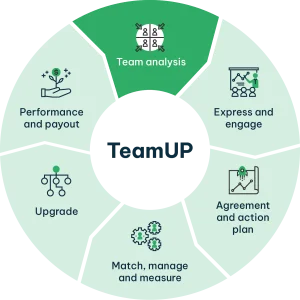From a distance, teams often seem like a black box: you can see the outcomes, whether good or bad, but what is really happening inside remains unclear. Why do some teams collaborate effortlessly while others struggle? What drives productivity in teams? How can you uncover and develop a team's hidden potential?
Many organizations turn to quick fixes: an inspiring workshop, a team outing, or an extra coaching session. But without thorough analysis, this often amounts to merely treating the symptoms. Without real insight, it remains a matter of muddling through and relying on false assumptions. Sometimes the problem runs deep, rooted in a lack of openness and trust. But we also encounter many teams where, for example, roles or goals are not clearly defined.
Team development takes time. Real change means breaking patterns and adjusting behavior. This requires a structured, measurable approach.
 The 10 development aspects of our TeamUP Program.
The 10 development aspects of our TeamUP Program.
The TeamUP Program
Our program offers a scientifically grounded method for systematically developing teams. We combine insights from literature—including the work of Lencioni and Tuckman—with our hands-on experience guiding hundreds of teams. Our model is based on 10 development aspects and 4 maturity levels, which we use to objectively analyze team dynamics. This approach not only provides insight into how a team functions but also helps uncover its growth potential.
The process consists of six steps designed to help teams grow in a focused and sustainable way. A safe environment is a critical foundation for any productive development program.
 The 6 steps of the TeamUP Program.
The 6 steps of the TeamUP Program.
1. Research: 'People analytics' and human insight
We begin the project with a kick-off session where we introduce ourselves, explain the TeamUP program, and establish the conditions
for a safe environment—a crucial prerequisite for a productive process. Next, we send out a questionnaire to all team members, collecting
both quantitative and qualitative data. Only a summarized report is shared, ensuring that individual responses cannot be traced back to
specific team members. This unique approach fosters a sense of safety, encouraging team members to respond honestly and allowing us to
get to the heart of the issues.
The results are then analyzed using our 10 development aspects and, if desired, compared to other teams within or outside the organization. The TeamUP Team Analysis provides an objective snapshot of where the team currently stands and highlights opportunities for improvement.
2. Workshop: Reflecting back Our team analysts accurately identify the core issues within the team. The outcomes are shared in an interactive session with the team, facilitated by an experienced team coach who is attuned to the sensitivities and dynamics at play. The workshop often leads to many 'aha' moments: team members recognize their own experiences and feelings in the results, or suddenly see clearly where the root of the problem lies. This not only creates awareness but also generates buy-in and commitment to the project.
3. Action Plan: Shared responsibility
Based on the insights from the analysis, we collaborate with the team to create an action plan. This plan outlines concrete areas for
improvement and the steps needed for the team to grow. Just as important as the content of the plan is the team’s involvement in shaping
it—this fosters a sense of ownership and encourages team members to take responsibility for the change.
4. Implementation: Working on growth
The team begins working on the improvement actions. This can be done independently, but the process is often supported by one or more of
our experienced team coaches.
5. Adjustment: Targeted interventions
After a few months, we evaluate progress and conduct a follow-up measurement. Have the goals been achieved? Where is progress visible?
And which areas still require attention? We have developed a 'toolbox' containing instruments for each focus area—allowing us to take
precise and effective interventions where needed most.
6. Realization: Celebrating success
Once the goals have been achieved, we take time to reflect on the progress made. We mark the occasion with a celebratory closure
event—often a team activity or outing.
 The various TeamUP maturity levels of team development (source: Tuckman).
The various TeamUP maturity levels of team development (source: Tuckman).
Why TeamUP Works
Developing and growing teams is not a matter of chance, but of insight, structure, and targeted action. We do this based on five pillars:
- Data-driven approach: no assumptions, but concrete insights
- Safe environment: anonymity in analysis, connectedness in the process
- Tailored to each team: no one-size-fits-all solution, but a program customized to specific challenges
- Proven methodology: supported by science and practical experience
- Control: monitor progress through our dashboards
Do you want to sustainably strengthen teams in your organization? With TeamUP, you gain a proven, measurable approach. Get in touch with us and discover the possibilities.



